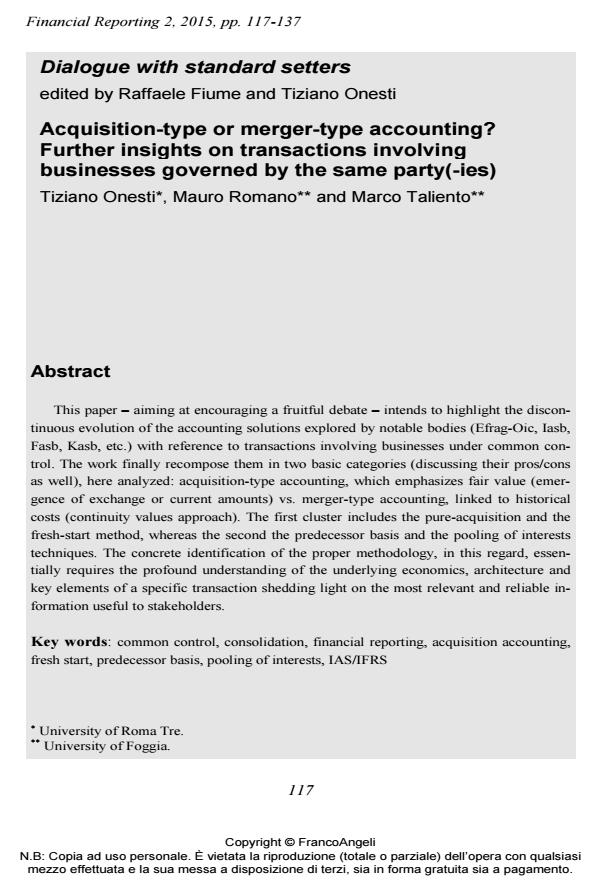Acquisition-type or merger-type accounting? Further insights on transactions involving businesses governed by the same party(-ies)
Titolo Rivista FINANCIAL REPORTING
Autori/Curatori Tiziano Onesti, Mario Romano, Marco Taliento
Anno di pubblicazione 2016 Fascicolo 2015/2
Lingua Italiano Numero pagine 21 P. 117-137 Dimensione file 250 KB
DOI 10.3280/FR2015-002005
Il DOI è il codice a barre della proprietà intellettuale: per saperne di più
clicca qui
Qui sotto puoi vedere in anteprima la prima pagina di questo articolo.
Se questo articolo ti interessa, lo puoi acquistare (e scaricare in formato pdf) seguendo le facili indicazioni per acquistare il download credit. Acquista Download Credits per scaricare questo Articolo in formato PDF

FrancoAngeli è membro della Publishers International Linking Association, Inc (PILA)associazione indipendente e non profit per facilitare (attraverso i servizi tecnologici implementati da CrossRef.org) l’accesso degli studiosi ai contenuti digitali nelle pubblicazioni professionali e scientifiche
This paper - aiming at encouraging a fruitful debate - intends to highlight the discontinuous evolution of the accounting solutions explored by notable bodies (Efrag-Oic, Iasb, Fasb, Kasb, etc.) with reference to transactions involving businesses under common control. The work finally recompose them in two basic categories (discussing their pros/cons as well), here analyzed: acquisition-type accounting, which emphasizes fair value (emergence of exchange or current amounts) vs. merger-type accounting, linked to historical costs (continuity values approach). The first cluster includes the pure-acquisition and the fresh-start method, whereas the second the predecessor basis and the pooling of interests techniques. The concrete identification of the proper methodology, in this regard, essentially requires the profound understanding of the underlying economics, architecture and key elements of a specific transaction shedding light on the most relevant and reliable information useful to stakeholders.
Parole chiave:Common control, consolidation, financial reporting, acquisition accounting, fresh start, predecessor basis, pooling of interests, IAS/IFRS
- Dialogue with standard setters. Business Combinations under Common Control: Concerns, Criticisms and Strides Raffaele Fiume, Tiziano Onesti, Mauro Romano, Marco Taliento, in FINANCIAL REPORTING 1/2015 pp.107
DOI: 10.3280/FR2015-001005
Tiziano Onesti, Mario Romano, Marco Taliento, Acquisition-type or merger-type accounting? Further insights on transactions involving businesses governed by the same party(-ies) in "FINANCIAL REPORTING" 2/2015, pp 117-137, DOI: 10.3280/FR2015-002005